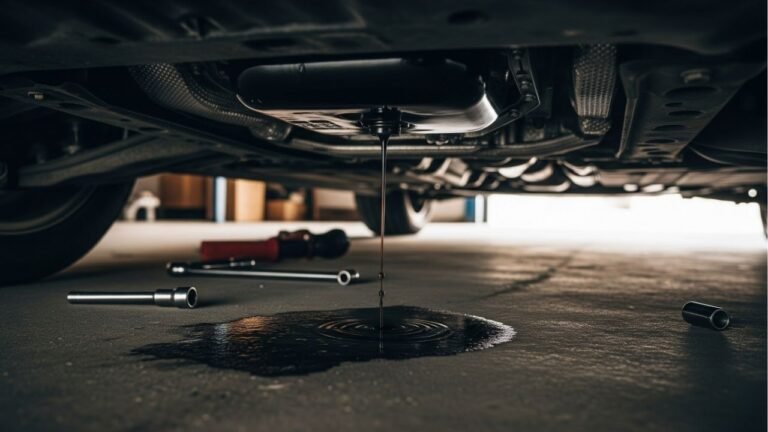Truth About Oil Capacity for My Car: A Friendly Guide

Have you ever asked yourself, “What is the right oil capacity for my car?” You’re not alone! Whether you’re changing your own oil or double-checking a mechanic’s work, knowing how much oil your engine takes is essential. It’s not just about topping off fluid—it’s about engine health, performance, and long-term reliability.
I remember the first time I changed my own oil—I was proud but nervous. I kept wondering if I had added too little… or way too much. The car manual felt like ancient scripture, and Google gave me ten different answers. But that moment sparked a journey into truly understanding how vital oil capacity is for every car, including your car.
In this guide, we’ll break it all down—what oil capacity is, how to find it, why it varies, and how you can get it just right. We’ll also tackle common myths and mistakes and offer simple advice that feels like it’s coming from a friend—not a textbook.
What Does “Oil Capacity for My Car” Actually Mean?

Imagine your engine as the heart of your car, and the oil is its lifeblood. If you don’t give it enough, the parts won’t stay lubricated. Give it too much, and you could cause pressure issues or foaming—like pouring too much soda into a small glass.
Here’s why knowing the exact oil capacity for my car is a must:
-
Prevents engine wear due to under-lubrication
-
Avoids overfilling which can damage seals and gaskets
-
Saves money by preventing unnecessary engine repairs
-
Optimizes fuel efficiency and performance
-
Protects your engine warranty (yes, overfilling voids some!)
Why Oil Capacity Varies From Car to Car
You might be wondering, “Why can’t all cars just use the same amount of oil?” The answer lies in engineering. Just like people have different health needs, cars do too. Factors like engine size, cylinder count, oil pan shape, and turbocharging all affect oil capacity.
Let’s compare a few real-world examples:
| Vehicle Type | Engine Size | Approx. Oil Capacity |
|---|---|---|
| Honda Civic (1.8L) | 4-cylinder | 3.9 quarts |
| Ford F-150 (5.0L V8) | 8-cylinder | 7.7 quarts |
| Toyota Corolla (2.0L) | 4-cylinder | 4.4 quarts |
| BMW X5 (3.0L Turbo) | 6-cylinder | 6.9 quarts |
That’s quite the range, right? Now you understand why asking about the oil capacity for my car specifically is so important.
How to Find the Right Oil Capacity for My Car
If you’re like me, the first place you’ll check is Google. But online forums can be confusing, and even the same model might have different engines. Here’s how to find the accurate info without guessing:
Top 5 Ways to Check Oil Capacity:
-
Owner’s Manual – Your car’s bible. Usually found in the glove box.
-
Oil Cap or Dipstick – Some cars have the capacity listed right on them.
-
Manufacturer’s Website – Look up your VIN for precise specs.
-
Reliable Automotive Websites – Edmunds, AutoZone, or Mobil 1’s database.
-
Mechanic or Dealership – Especially helpful for older or modified cars.
Pro Tip: If you’ve changed the oil filter or flushed the engine, always add a little more than the base capacity. Filters hold about 0.2–0.5 quarts.
Personal Story: The Time I Overfilled and Regretted It
Let me tell you about the time I thought, “A little more oil won’t hurt.” Spoiler alert—it did.
Driving my trusty Toyota after a DIY oil change, I felt something off. The engine was louder, and the idle was rough. Turns out, I had added almost a quart too much oil. I had to drain and start over. Lesson learned!
This is why it’s so critical to know the correct oil capacity for my car before even touching a wrench. Don’t eyeball it—check and double-check.
How Temperature and Driving Style Affect Oil Volume
Here’s a subtle truth that many overlook: climate and driving habits affect oil behavior. While your oil capacity stays the same, how oil behaves can change based on these external factors.
In hot climates, oil thins faster, especially if you’re using a light viscosity like 0W-20. In cold climates, thick oil doesn’t flow as well. If you’re a frequent high-speed driver or often idle in traffic, your engine demands more protection, meaning clean, well-measured oil is non-negotiable.
So while you’re not changing the oil quantity based on seasons, you do need to stick closely to your car’s required oil capacity and change intervals.
Common Mistakes Drivers Make with Oil Capacity
Even seasoned car owners make mistakes when it comes to oil levels. Some of these errors are small but can lead to costly problems down the road.
Top Mistakes:
-
Overfilling the engine oil
-
Forgetting to replace the oil filter
-
Using the wrong oil grade
-
Not checking oil after filling
-
Assuming all engines of the same car model are identical
Every time I hear someone say, “I just put in whatever fits,” my inner mechanic cringes. That’s how engines get ruined. The proper oil capacity for my car isn’t a suggestion—it’s a rule.
Signs Your Car Has the Wrong Oil Level
How can you tell if something’s off after an oil change? Here are some classic symptoms:
-
Oil light flickering
-
Unusual engine noise
-
Exhaust smoke
-
Oil leaks or drips under the car
-
Poor fuel economy
If any of these show up after your oil change, double-check your oil level using the dipstick method. Also, wait about 10 minutes after turning the engine off for an accurate reading.
DIY Oil Change: Getting the Capacity Just Right
Changing your own oil feels empowering. But many DIYers either underfill or overfill. Let me walk you through my personal routine, which I learned after many trial-and-error afternoons (and a few oil-stained driveways).
Here’s what I do:
-
Step 1: Drain the oil completely. Let the old oil flow out fully—don’t rush.
-
Step 2: Replace the filter. A fresh filter ensures full oil circulation.
-
Step 3: Add 80% of your engine’s capacity. Then, wait a few minutes.
-
Step 4: Check the dipstick. Top up little by little until it reaches the full mark.
-
Step 5: Run the engine for 3–5 minutes. Recheck and adjust if needed.
Don’t skip that recheck step—oil settles, and you’ll get a more accurate level after running the engine. This simple process helped me hit the perfect oil capacity for my car every time.
The Relationship Between Oil Type and Capacity
Now, let’s talk oil types. You’ve got conventional, synthetic blend, and full synthetic oils. While the type of oil doesn’t change your car’s required volume, it does affect performance and longevity.
A Quick Breakdown:
-
Conventional Oil: Cheaper but breaks down faster.
-
Synthetic Blend: Middle ground—better temperature resistance.
-
Full Synthetic: Ideal for modern engines, lasts longer, and performs better in extremes.
Some high-performance vehicles actually require full synthetic because it maintains viscosity better, especially at high temperatures. Still, the oil volume remains based on your engine’s specs.
So even though I prefer synthetic in my daily driver, I always stick to the exact oil capacity for my car—no matter what oil brand or type I use.
How Often Should You Check Oil Capacity?
You don’t need to wait until your next oil change to check the oil level. In fact, checking once every two weeks or before long trips is a great habit.
I once caught a slow leak before a road trip by doing this simple check. It saved my engine—and probably the vacation too.
Look, even if your car is new or has synthetic oil, it doesn’t mean it’s immune to oil loss. Here are a few times when you should absolutely check your oil:
-
After long highway drives
-
When parked on inclines frequently
-
If you notice a burning smell or smoky exhaust
-
During seasonal temperature shifts
Trust me, spending two minutes checking oil can save you thousands in engine repairs.
Bullet Points: When to Be Extra Careful About Oil Capacity
-
When using aftermarket oil filters (they may differ in volume).
-
If the engine was completely rebuilt or flushed.
-
After towing heavy loads (your engine runs hotter).
-
If driving in extreme weather—hot or freezing.
-
When switching oil types (some synthetics expand differently under heat).
Sticking to the correct oil capacity for my car has helped me drive stress-free across long hauls, bumpy roads, and city traffic jams without worry.
Does Engine Age Affect Oil Capacity?
You’d think a car engine’s needs stay the same as it gets older, but nope—age changes everything.
As an engine wears, clearances between parts increase. Older engines may burn more oil or develop minor leaks, which means your oil level might drop quicker even though the capacity stays the same.
A little trick I use? I check my dipstick more often on older cars, and I sometimes add oil stabilizers to improve viscosity. If your engine’s pushing 150,000+ miles, it’s a smart move to monitor oil more actively.
So yes, even with older engines, knowing the oil capacity for my car ensures I don’t overfill while topping off.
FAQs: Real Questions About Oil Capacity for My Car
Q1: How can I find the oil capacity if I lost my manual?
A: You can check the manufacturer’s website using your VIN, visit sites like Mobil 1’s lookup tool, or call your dealership. Your engine size and trim affect the capacity.
Q2: Can overfilling just a little hurt my engine?
A: Even small overfills can foam the oil, increasing pressure and damaging seals. Always aim for the exact amount.
Q3: Should I include the oil filter when calculating capacity?
A: Yes, always. A new filter holds around 0.2 to 0.5 quarts depending on size.
Q4: How do I know if my car has too little oil?
A: Look for signs like ticking noises, overheating, or a flickering oil light. Check the dipstick regularly.
Q5: Do hybrids or electric vehicles need oil?
A: Hybrids with gas engines still need oil—often low-friction types. Pure EVs don’t require engine oil at all.
Q6: Is it okay to switch from conventional to synthetic oil?
A: Absolutely. Just be sure to stick with the same oil capacity for your car, regardless of oil type.
Q7: Can I use a larger oil filter for more oil capacity?
A: Not recommended. Stick to OEM specifications—larger filters may not seal correctly or fit safely.
Q8: Why does my dipstick read differently after an oil change?
A: Oil takes time to circulate. Always run the engine a few minutes, let it sit, then check again.
Wrapping Up: It’s All About Knowing Your Car
Cars aren’t just machines—they’re companions on the road. I’ve laughed, cried, and grown up with mine. That’s why I pay attention to things like oil capacity for my car—because taking care of it means it’ll take care of me.
When I first started driving, I thought oil was just “top it off and go.” But with time, I learned that the right oil, in the right amount, is like feeding your body a healthy meal. It helps everything run smoother and last longer.
So next time you’re about to pour in that oil, take a breath, check your numbers, and give your car exactly what it needs. After all, it’s not just about maintenance—it’s about connection, trust, and keeping the journey going.






